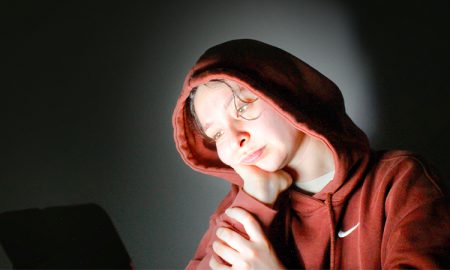Sweat rushes down your face as you get ready to speak in front of your class. You stand up in the front of the room and everyone’s eyes focus on you. You went over this moment a million times in your head but still get frightened after seeing your peers’ facial expressions. This is what many students have endured after two years of taking online classes in the comfort of their homes. This feeling is the new norm for many.

Social anxiety has been growing amongst students in community colleges. A study from the ASU science journal from 2020 found that a total of 29 students across nine different community colleges in the Southwestern U.S. have experienced symptoms of social anxiety. Social anxiety is described by the National Institute of Mental Health as the persistent fear of social performance situations and the fear that one can be embarrassed by one of these situations. This is different from general anxiety disorder, which is described as a persistent feeling of dread or worry that interferes with an individual’s daily life, also found in the National Institute of Mental Health.
Online courses have helped reduce the symptoms of social anxiety by eliminating some of the fears present in the classrooms. But as more students return to campus, the symptoms have increased for many.
“Social anxiety is not the fear of people, but rather the fear of their judgment and evaluation of you,” says Dana Timmermans, the director of behavioral health services and a therapist at Fullerton College.
Online education is convenient for most students, especially for those who have a busy schedule or work often. Students state that some of the pros of taking online classes are being in your own space and being able to control time management. It can also reduce the anxiety some students face by not requiring them to be physically present in class and lessen rejection and pressure.
Along with this, it is simply just overall more convenient for students to take classes from home. “Going according to the college schedule is also kinda a burden financially,” says Fullerton College student Shenzad Malik. When students commute to campus, they often need to pay for their own gas and own car insurance. Even for the students who don’t drive and take public transportation, time and money adds up.
According to Timmermans, avoidant behavior is a part of social anxiety that over time gets worse. While online classes allow faster and easier acquisition, it offers little opportunity to practice new skills in a social environment in what works or what doesn’t work. He also shares that with online education, it’s harder to see if someone is experiencing social anxiety online than in person. The professionals are able to interact with the students to read and observe their body languages.
“If you’re online, I don’t get to see or read your body language. I don’t get to see the sense of you not looking directly at my eye so it decreases the anxiety a little bit for people, but doesn’t allow them to practice the behaviors to improve their symptoms,” he says.
There has been an increase in those who experienced depression and social anxiety symptoms since the lockdown also due to this. Many were unable to have social contact with family and friends. Being isolated for a long period of time may have worsened people’s anxiety.
Timmermans says in-person education pushes students to interact with others to build a connection and be able to concentrate more in a classroom environment. “That’s because they learn to adapt the skills in social situations but I don’t think we’ll see that online. I think it doesn’t allow for that healing to happen in your life,” says Timmermans.

According to Darnell Kemp, a distance learning specialist at Fullerton College, about 75% of students take online classes in the spring semester of 2022.
“Most of our students weren’t taking a full load, they were taking one or two classes to fit in and balance our schedule. So of course in the last couple of years, students have been forced to squeeze a lot of this online and naturally created extra anxiety,” says Kemp.
“Sometimes what causes anxiety then is when students go right into assignments instead of going into the course the way the instructor thinks they’ll go into the course,” says Kemp.
Many with social anxiety would misinterpret someone’s expressions and have the fear of being judged. An example is when in person, you’re able to hear someone’s tone when speaking but, online, it’s harder to tell online especially in discussion board posts.
Online classes can be hard to manage especially when asynchronous, or fully online with no Zoom meetings. More responsibilities fall on the students’ plate and with their life going on, the students’ stress level increases. There is more demand for online education and you have to be more responsible in your classes. It can be difficult to manage for some students.
“A lot of people coming in from high school who graduated online, haven’t talked to one another for two years, very stressful,” says Anthony Trapolino, a student at Fullerton College.
For some majors, there are benefits in being in a personal environment for the experiences and being able to learn in their fields. An example would be human services majors, interdisciplinary degrees that require physical meetings or scenarios that require face-to-face interactions.
“Being in school, it helps me socialize with people and communicate,” says Gilbert Villegas, a student at Fullerton College.
According to Fullerton College students that were interviewed, online education causes many to lose the motivation to learn and not retain the information due to the lack of social interaction. It’s hard for many students to stay for two hours and focus during online learning.
“If I wasn’t at school, I would feel like I’d have more social anxiety going out and just not being exposed to a lot of people,” says Villegas.
While returning to in-person classes has caused a lot of social anxiety and even increased it for those who had it before the COVID-19 pandemic, there are ways to get help. Mindfulness courses and mental health resources are available for Fullerton College students.
Cognitive behavior therapy is the most common form of therapy that helps people who have social anxiety. It works to improve their current and future relationships. “Some folks have also benefited with antidepressants,” says Dana Timmermans, the director of behavioral health services and a therapist at Fullerton College. He also says that symptoms of social anxiety can simply decrease over time without the use of medications and therapy.
“The sooner you interrupt that, ‘You know, people don’t really care about me. They’re not really thinking about me, they’re thinking about their own issues and not thinking about me,’ the sooner you learn that process, the faster you’ll go to health.”

